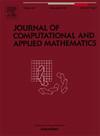Regularity and an adaptive finite element method for elliptic equations with Dirac sources on line cracks
IF 2.1
2区 数学
Q1 MATHEMATICS, APPLIED
Journal of Computational and Applied Mathematics
Pub Date : 2025-01-01
DOI:10.1016/j.cam.2024.116466
引用次数: 0
Abstract
In this paper, we consider an adaptive finite element method for solving elliptic equations with line Dirac delta functions as the source term. Instead of using a local local indicator, or regularizing the singular source term and using the classical residual-based a posteriori error estimator, we propose a novel a posteriori estimator based on an equivalent transmission problem. This equivalent problem is defined in the same domain as the original problem but features a zero source term and nonzero flux jumps along the line cracks, leading to a more regular solution. The a posteriori error estimator relies on meshes that conform to the line cracks, and its edge jump residual essentially incorporates the flux jumps of the transmission problem on these cracks. The proposed error estimator is proven to be both reliable and efficient. We also introduce an adaptive finite element algorithm based on this error estimator and the bisection refinement method. Numerical tests demonstrate that quasi-optimal convergence rates are achieved for both low-order and high-order approximations, with the associated adaptive meshes primarily refined at a finite number of singular points in the domain.
求助全文
约1分钟内获得全文
求助全文
来源期刊
CiteScore
5.40
自引率
4.20%
发文量
437
审稿时长
3.0 months
期刊介绍:
The Journal of Computational and Applied Mathematics publishes original papers of high scientific value in all areas of computational and applied mathematics. The main interest of the Journal is in papers that describe and analyze new computational techniques for solving scientific or engineering problems. Also the improved analysis, including the effectiveness and applicability, of existing methods and algorithms is of importance. The computational efficiency (e.g. the convergence, stability, accuracy, ...) should be proved and illustrated by nontrivial numerical examples. Papers describing only variants of existing methods, without adding significant new computational properties are not of interest.
The audience consists of: applied mathematicians, numerical analysts, computational scientists and engineers.

 求助内容:
求助内容: 应助结果提醒方式:
应助结果提醒方式:


